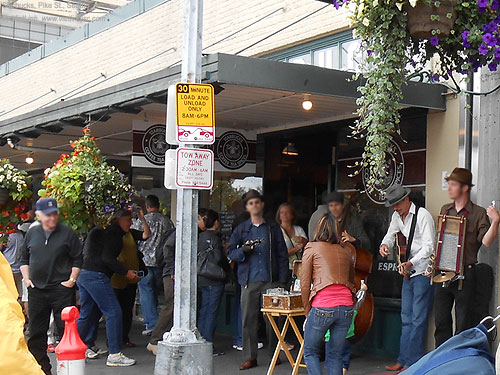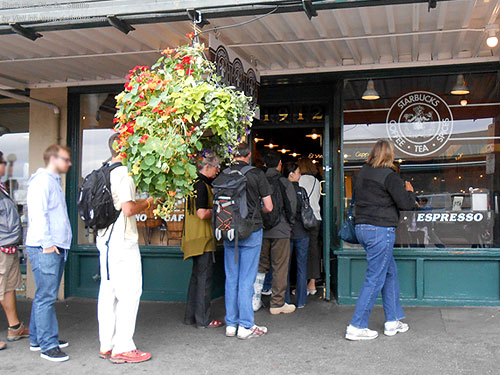In February 2013, Starbucks opened its first coffee store in Vietnam. Mr. John Culver, president of Starbucks Coffee China and Asian Pacific says Starbucks commits to use more high-quality Arabica coffee of Vietnam. At the same time, Starbucks will help Vietnamese farmers to develop Arabica coffee by sharing knowledge and experience with them.
After Starbucks officially appeared in Vietnam, Trung Nguyen Group Corp., the biggest company producing coffee in Vietnam, announced its ambition of buying coffee roasters in the United States, and opening stores in Starbucks’s hometown, the City of Seattle. Will Trung Nguyen be successful with its plan of entering the U.S. market?
While young adults excitedly wait in lines in the biggest and liveliest city of Vietnam, Ho Chi Minh City, Vietnamese farmers growing coffee are wondering when Starbucks will begin its commitment to help them with their farming.
The world's largest coffee roasters, including Kraft Foods, Sara Lee, Nestle, Tchibo, and Starbucks, are also the world's leading coffee buyers. Will Starbucks bring benefits for Vietnamese farmers like other companies have been doing here? For example, since Cargill came to Vietnam, it has helped people to grow cocoa with UTZ standard. This is successfully implemented in many provinces like Ben Tre, and Ba Ria Vung Tau while procurements have been established as it committed.
Main markets for coffee in Europe andthe United States begin to consume coffee with specific criteria. This is abarrier for our products. Even though Vietnamese coffee has high quality, without techniques for growing and preparation, our coffee may not be qualified for those criteria.
To be certified with those standards, in addition to strict techniques, people also have to pay for fees like registration fees, member fees, inspection fees, and so on. However, coffee with standards costs higher than normal coffee.
Statistics show that only about 10% coffee in Vietnam is certified UTZ or 4C while other small numbers are qualified for Rainforest, Fairtrade and Organic. Some of the standards Vietnam currently applies for coffee include TVCN 4293:2003; TCVN 4193:2005; TCVN 7032:2007 (ISO 10470:2004).
Some current international standards for coffee:
UTZ Certified (2007) ispopular in the Netherlands and northern Europe. UTZ is certified for coffee whose sources of shipments are accessible and which qualified for social and environmental criteria.
4C certificate (2006), Common Code for the Coffee Community, ensures the sustainability of social, environmental and economic development. It concentrates on coffee which can ensure working conditions, and activities of workers; forest and natural resources protections including water, land, biological diversity and energy; the development of social and environmental sustainability.
Fair Trade certification (1997) is popular in the UK, France, and the USA. The certification promotes the fairness in commerce. Trading is implemented with dialogue, transparency and mutual respects between farmers, traders, and consumers.
Rainforest Alliance Certification(1992) is used in Japan and Western Europe. It is certified for products which contribute to the conservation of biological diversity and ensure the sustainable life through innovative land uses, sales and consumer behaviors.
Organic Certificationis common in Germany, Canada, Australia, Italy and the United States. Itcertifies management system in agricultural productions, which including covering soil with organic material, regulating shade tree and preventing diseases in abiological direction.
Consumers can support sustainable agricultural productions by buying products from farms with standards. In the Netherlands, more than 40% coffee is certified. In the United States, 16% imported coffee is certified. At the same time, Denmark, Sweden, Norway, Switzerland and Belgium have more than 10% coffee qualified for criteria. Certified coffee has grown 20-25% each year while regular coffee has only around 2% growth.
Since March 2010, Starbucks started to apply Fair Trade to its coffee for all types of espresso drinks in Europe. In 2011, Sara Lee committed to increase the buy of coffee having UTZ Certified Good Inside in the next five years by about three times. In May 2011, Kraft Food announced it would use 100% sustainable coffee to supply for the European market in 2015.

The first Starbucks’ shop was opened by a writer and two teachers. After it was moved from Western street to Pike street. It is the only place in more ten thousands Starbucks shops which still uses the original brown logo of the company. Other shops throughout the world have to use Starbucks’s famous greenlogo today. Photo taken by ViệtLinh.

Every day, visitors still patiently wait in front of this oldest Starbucks shop to enjoy cups of coffee in Pike Place Market, Seattle, Washington state (US). Photo taken by Việt Linh.
According to the Ministry of Agriculture and Rural Development, in 2012, Vietnam's coffee growing area is nearly 615,000 hectares while the target of expansion is to have only 500,000 hectares in 2020. In 2012, coffee exports reached 1.7 million tons; turnover reached USD 3.4 billion, increasing 36% compared to 2011 and reaching a record high in the history of Vietnam's coffee exports. Is this development just like the tremendous expansion of Trafish farming area in the Mekong Delta in the past?
In the world, Arabica flavor is a more preferred than Robusta coffee. The average price of Arabica coffee is 1.5 to 2 times higher than Robusta’s. According to Coffee and Cocoa Association of Vietnam, the total area of Arabica coffee in our country is around 32,000 -35,000 hectares. The development plan of the Ministry of Agriculture and Rural Development intends to keep the area of Arabica in only 40,000 hectares in 2020 since this type of coffee requires complex arable land and climate conditions. Has Vietnam reached the limit of Arabica coffee growing area?
In the last five years, the average productivity of coffee in Vietnam has reached 2 tons / hectare, higher by half compared with Indonesia. We have reached the highest level in the production in countries growing Robusta coffee. This is a high threshold for Robusta to bemore developed in Vietnam.
80% of coffee in Vietnam is located in household farms. In order to form a sustainable and centralized production, farmers must have technical and financial investment. Who will help them?
Should we apply sun exposure or dryer for our coffee? Farmers need yard for drying if we exploit the sun. Using dryers requires machines and financial investment. There was a long time people picked immature coffee beans for sale. This reduced both quality and price of coffee. But if they didn’t harvest them early, the price would decline and… thefts would occur.
More than 90 percent of Vietnam's coffee export is coffee bean. Vietnamese coffee is often traded at low prices due to the lack of international standards. Coffee price is also fluctuating in international markets. This significantly influences the domestic price. Without temporary storages, some farmers have to sell their coffee quickly despite its low price.
* Data are combined from newspapers and websites
© Sonia - Viet Linh. Feb 07, 2013